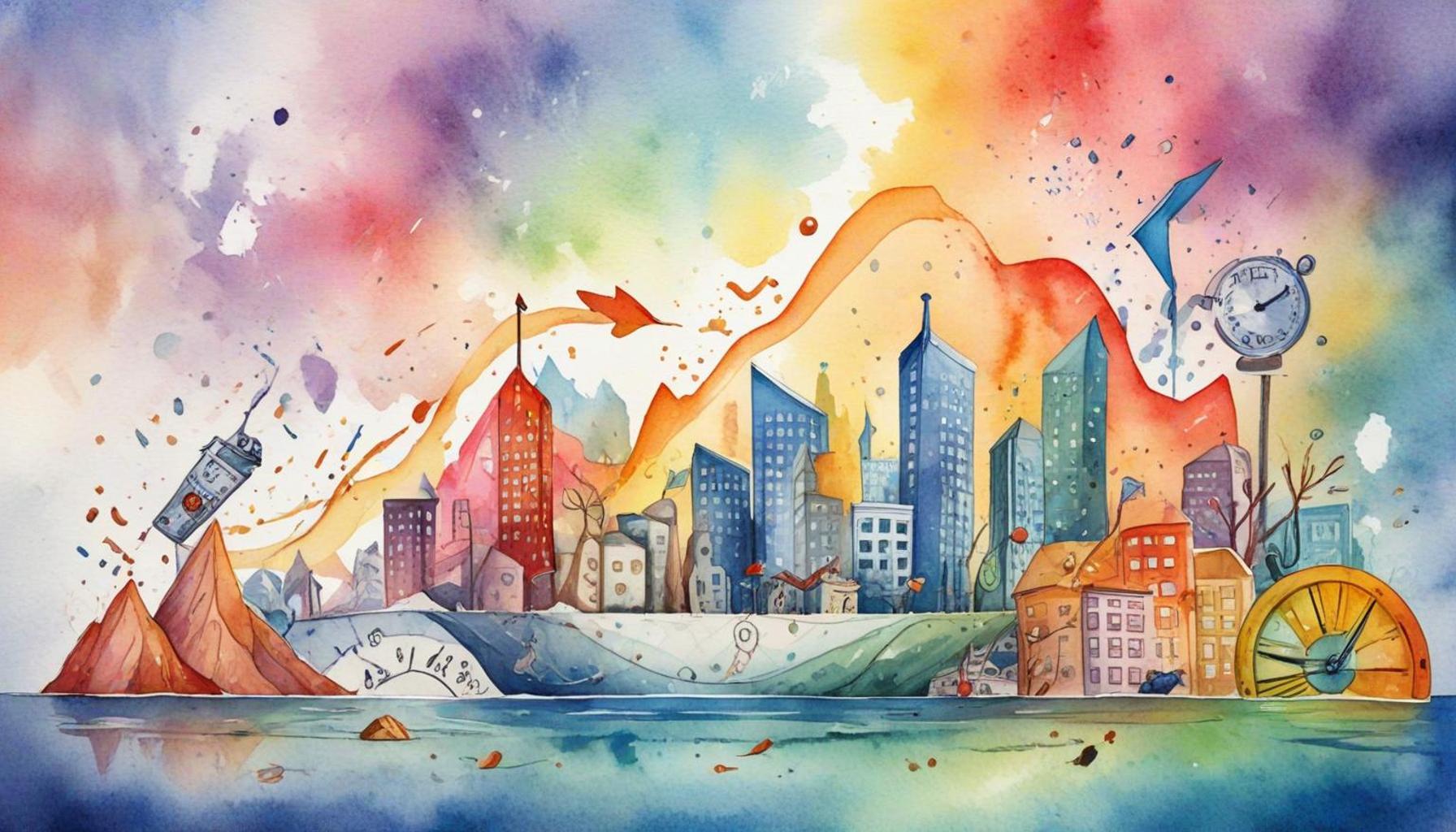The Impact of Interest Rates on Corporate Financial Management: Strategies for Navigating Times of Uncertainty

Understanding Interest Rates
Interest rates significantly influence the financial decisions made by corporations. They determine how much it costs for businesses to borrow money, which directly impacts their operational expenses and long-term financial planning. For instance, when a company considers expanding its operations or launching a new product line, it often needs to secure financing. The prevailing interest rate during that time can make a huge difference in the overall cost of that financial commitment.
Key Impacts of Interest Rates on Corporations
- Cost of Capital: Higher interest rates raise the costs associated with borrowing. For example, if a company like ABC Manufacturing needs a $1 million loan at a 5% interest rate, its annual payment will be significantly different compared to a 10% rate. Consequently, this increase compels corporations to reconsider their capital structure, possibly opting for more equity financing or retaining earnings rather than incurring additional debt.
- Investment Decisions: Rising interest rates can lead to a slowdown in capital expenditures. If Company XYZ is considering investing in new machinery but faces increased borrowing costs, it may choose to delay the purchase or scale back its investment. This hesitancy can impact the company’s growth trajectory and market competitiveness, as other firms may seize opportunities during these periods of indecision.
- Cash Flow Management: Changes in interest rates can complicate cash flow forecasting and management. For example, if a business has floating-rate loans, increases in interest rates can lead to higher monthly repayments. As a result, firms must adopt more dynamic cash flow strategies to ensure liquidity and operational continuity, particularly in fluctuating economic conditions.
During volatile economic times, effective financial management strategies become crucial for corporations to navigate these challenges. Grasping the implications of interest rate movements is fundamental for implementing responsive financial tactics.
Strategies for Navigating Financial Uncertainty
- Diversifying Funding Sources: Companies can reduce their dependency on traditional bank loans by exploring alternative funding avenues such as private equity, crowd-funding, or venture capital. This diversification not only spreads risk but can also provide access to more favorable lending terms.
- Interest Rate Hedging: Businesses can utilize financial instruments, such as interest rate swaps or options, to hedge against fluctuations. For example, if a company expects rising rates, it might enter into a swap agreement to convert its variable-rate debt to a fixed rate, thereby stabilizing its debt service costs and enhancing budgeting accuracy.
- Scenario Analysis: Conducting thorough stress tests and modeling different interest rate environments can be instrumental in strategic planning. By examining how various scenarios could impact cash flow, profitability, and overall financial health, companies can better prepare for the uncertainties of the market.
By proactively addressing the implications of interest rates, businesses can bolster their resilience and secure their financial standing, ensuring stability even amidst overall economic uncertainty. Effective management of these factors can not only safeguard assets but also fuel sustainable growth in challenging times.
DISCOVER MORE: Click here for insights on data analysis in finance
The Significance of Interest Rates in Financial Decision-Making
Understanding interest rates is crucial for corporate financial management, as they play a pivotal role in shaping a company’s approach to financing and investment. When interest rates fluctuate, they can have wide-ranging consequences on a corporation’s cost structure and strategic positioning. For example, a sudden increase in interest rates may force a company to reconsider its plans for expansion or new ventures, leading to changes in budget allocations and resource management.
Understanding the Cost of Capital
The cost of capital is fundamental to making informed investment decisions. It essentially represents the return that a company needs to generate to cover its debt and equity costs. When interest rates rise, the cost of borrowing increases, which directly impacts the cost of capital. Companies may find that projects they once deemed feasible become less attractive as higher interest payments reduce potential profits. This scenario compels businesses to evaluate their financing options more critically.
- Example: Consider a tech startup looking to raise $500,000 for product development. If the prevailing interest rate is 4%, the company might find a loan manageable. However, if rates escalate to 8%, the burden of securing that same amount significantly increases. This could lead the startup to seek alternative funding sources, such as angel investors or venture capital, which may come with different strings attached.
The Effect on Investment Strategies
Interest rates also influence investment decisions, particularly regarding capital expenditures. Companies may be more reluctant to undertake significant investments when borrowing costs are high. This wariness can hinder growth and innovation, as businesses may delay necessary upgrades to equipment or technology that could enhance their competitive edge.
- Example: A manufacturing firm might decide to postpone the acquisition of advanced machinery if it anticipates higher loan costs. This decision could potentially stymie productivity improvements and shift the competitive landscape in favor of rivals who proceed with their capital investments.
Cash Flow and Operational Considerations
Shifts in interest rates also impact cash flow management. Companies with outstanding loans tied to variable interest rates may see their monthly expenses rise as rates climb, squeezing their cash flow. To maintain operational stability and ensure they can meet financial obligations, businesses must adapt their cash flow strategies, often leading to a more conservative approach to spending and investment.
- Example: A restaurant chain with a floating-rate loan that becomes more expensive due to rising interest rates may decide to alter its expansion plans. By focusing on cost-cutting measures and optimizing existing operations, the chain can navigate challenging financial waters without jeopardizing its long-term viability.
In summary, the interplay between interest rates and corporate financial management is complex yet essential to understand. As businesses face potential fluctuations in these rates, they must remain agile and strategic in their financial planning. In the following sections, we will explore practical strategies companies can implement to effectively navigate these challenges and safeguard their financial health in uncertain times.
DISCOVER MORE: Click here to learn how to choose the perfect credit card
Strategies for Managing Financial Risk Amidst Interest Rate Fluctuations
As interest rates remain subject to volatile shifts due to economic pressures and monetary policy, companies must adopt proactive strategies in their financial management practices to mitigate risks. Understanding how to navigate these uncertainties can mean the difference between a thriving organization and one that falters in the face of rising costs.
Interest Rate Hedging Techniques
One robust strategy that corporations can utilize to manage exposure to interest rate fluctuations is hedging. This involves using financial instruments, such as derivatives, to offset potential losses in their borrowing costs. For instance, a company expecting a future increase in interest rates could enter into an interest rate swap agreement. This allows them to exchange variable interest rate payments for fixed ones, thereby stabilizing cash outflows and providing predictability in their financial planning.
- Example: Suppose a large retailer has loans with variable rates and anticipates rising interest rates. By engaging in an interest rate swap, the retailer converts its variable payments to fixed payments. This not only stabilizes cash flow but also allows the retailer to budget more effectively for the long term.
Flexible Financing Options
Corporations can also explore flexible financing options to adapt to changing interest rates. Companies can negotiate terms that allow for prepayment or refinancing without incurring heavy penalties. This flexibility can empower them to better manage periods of high interest rates and avoid being locked into unfavorable terms.
- Example: A construction company with significant loans might negotiate flexibility that allows it to refinance when interest rates drop. If the company originally secured loans at a higher rate, the opportunity to refinance at a lower rate can lead to substantial long-term savings.
Prioritizing Debt Management
In uncertain economic climates, focusing on debt management becomes paramount. Companies should regularly assess their debt levels in relation to revenue and ensure that they maintain a manageable debt-to-equity ratio. By doing so, they can improve financial stability and position themselves favorably for future growth, regardless of interest rate fluctuations.
- Example: A mid-sized manufacturing firm may find itself burdened with high debt due to previous expansion efforts when interest rates were lower. To navigate the pressures of rising rates, the firm can implement a debt repayment strategy to reduce overall liabilities, improving its creditworthiness and financial agility.
Enhancing Operational Efficiency
Lastly, enhancing operational efficiency is crucial when facing rising interest rates. Companies should continually seek methods to reduce costs and improve productivity, which can help offset increasing interest payments. Streamlining operations or investing in technology that enhances efficiency can free up cash flow, allowing for a stronger financial position.
- Example: A logistics firm may invest in advanced routing software that optimizes delivery routes, saving fuel and time. As a result, even when interest rates rise, the company benefits from ongoing cost savings that bolster its balance sheet and operational profitability.
By implementing these strategies, organizations can better shield themselves from the adverse effects of rising interest rates, positioning themselves to thrive through uncertainty. These proactive measures ensure that companies remain vigilant and adaptable, allowing them to maintain a competitive edge in challenging financial environments.
LEARN MORE: Click here for essential strategies
Conclusion
In closing, the impact of interest rates on corporate financial management cannot be underestimated. As we have explored, interest rate fluctuations pose both challenges and opportunities for businesses. Companies that proactively manage their financial strategies stand to not only survive but flourish during periods of uncertainty.
Utilizing tools such as hedging, organizations can effectively minimize exposure to rising borrowing costs, thus ensuring stability in cash flow. For instance, a company with variable-rate loans can use interest rate swaps to fixed rates to protect itself from sudden spikes in interest rates. This strategic approach enables the company to predict and stabilize its cash outflows, thereby enhancing its financial predictability.
By exploring flexible financing options, businesses can adapt to changing interest rates, allowing for strategic decision-making without the fear of punitive penalties. For example, a business might negotiate a line of credit or seek convertible bonds, which can be changed into equity if beneficial market conditions arise. This flexibility can create cushions against the financial stresses from potential interest rate hikes.
Additionally, prioritizing debt management ensures that companies maintain a solid financial foundation, enabling them to maneuver effectively through economic shifts. A well-managed debt portfolio allows organizations to leverage opportunities for expansion even in challenging times, such as when interest rates decline, leading to reduced borrowing costs. For instance, a firm could take advantage of lower rates to finance new projects or enhance operational capabilities without incurring excessive long-term debt.
Finally, continually enhancing operational efficiency allows firms to offset growing costs, fortifying their position in a competitive landscape. This can encompass streamlining production processes, adopting new technologies, or reevaluating supply chains to cut overhead expenses. Companies like Toyota exemplify this, as their commitment to lean manufacturing principles not only enhances productivity but also allows them to maintain competitive pricing even when market conditions fluctuate.
Ultimately, the ability to navigate the complexities of changing interest rates demands a keen understanding of financial management coupled with strategic foresight. As we have seen through practical examples, implementing these strategies empowers organizations not only to mitigate risks but also to seize opportunities for growth. Embracing this proactive mindset ultimately equips businesses to thrive, regardless of the economic climate.


